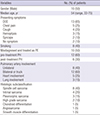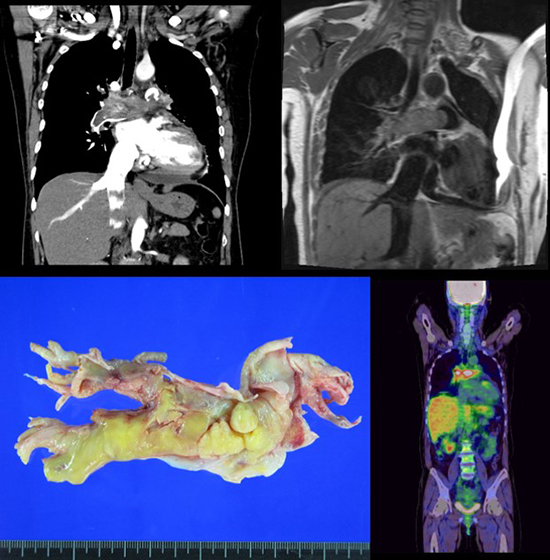1. Krüger I, Borowski A, Horst M, de Vivie ER, Theissen P, Gross-Fengels W. Symptoms, diagnosis, and therapy of primary sarcomas of the pulmonary artery. Thorac Cardiovasc Surg. 1990; 38:91–95.
2. Coskun U, Sinan UY, Calpar I, Yildizeli B, Yanartas M, Filinte D, Kucukoglu MS. Pulmonary artery sarcoma masquerading as chronic pulmonary thromboembolism. Tex Heart Inst J. 2014; 41:518–522.
3. Dornas AP, Campos FT, Rezende CJ, Ribeiro CA, Amaral NF, Corrêa Rde A. Intimal sarcoma of the pulmonary artery: a differential diagnosis of chronic pulmonary thromboembolism. J Bras Pneumol. 2009; 35:814–818.
4. Kerr KM. Pulmonary artery sarcoma masquerading as chronic thromboembolic pulmonary hypertension. Nat Clin Pract Cardiovasc Med. 2005; 2:108–112.
5. Kim MJ, Kim MS, Park JH, Park KI, Lee CS, Na MH, Lee JH, Choi SW, Jeong JO, Seong IW. Pulmonary artery angiosarcoma confused with acute pulmonary thromboembolism: focusing on clinical and echocardiographic features in the differentiation of two categories. J Cardiovasc Ultrasound. 2015; 23:44–47.
6. Mayer E, Kriegsmann J, Gaumann A, Kauczor HU, Dahm M, Hake U, Schmid FX, Oelert H. Surgical treatment of pulmonary artery sarcoma. J Thorac Cardiovasc Surg. 2001; 121:77–82.
7. Maruo A, Okita Y, Okada K, Yamashita T, Tobe S, Tanimura N. Surgical experience for the pulmonary artery sarcoma. Ann Thorac Surg. 2006; 82:2014–2016.
8. Xue H, Wu QY. Surgical treatment of primary pulmonary artery sarcoma. Chin Med J (Engl). 2011; 124:461–463.
9. Gan H, Zhang J, Feng L, Zhang Z, Liang L, Zhu G, Chen D. Diagnosis and surgical treatment of pulmonary artery sarcoma. Zhonghua Yi Xue Za Zhi. 2014; 94:1252–1254.
10. Mussot S, Ghigna MR, Mercier O, Fabre D, Fadel E, Le Cesne A, Simonneau G, Dartevelle P. Retrospective institutional study of 31 patients treated for pulmonary artery sarcoma. Eur J Cardiothorac Surg. 2013; 43:787–793.
11. Rossi A, Zompatori M, Tchouante Tchouanhou P, Amadori M, Palazzini M, Conficoni E, Galiè N, Poletti V, Gavelli G. Rare causes of pulmonary hypertension: spectrum of radiological findings and review of the literature. Radiol Med (Torino). 2014; 119:41–53.
12. Bacha EA, Wright CD, Grillo HC, Wain JC, Moncure A, Keel SB, Donahue DM, Mathisen DJ. Surgical treatment of primary pulmonary sarcomas. Eur J Cardiothorac Surg. 1999; 15:456–460.
13. Huo L, Moran CA, Fuller GN, Gladish G, Suster S. Pulmonary artery sarcoma: a clinicopathologic and immunohistochemical study of 12 cases. Am J Clin Pathol. 2006; 125:419–424.
14. Tavora F, Miettinen M, Fanburg-Smith J, Franks TJ, Burke A. Pulmonary artery sarcoma: a histologic and follow-up study with emphasis on a subset of low-grade myofibroblastic sarcomas with a good long-term follow-up. Am J Surg Pathol. 2008; 32:1751–1761.
15. Blackmon SH, Rice DC, Correa AM, Mehran R, Putnam JB, Smythe WR, Walkes JC, Walsh GL, Moran C, Singh H, et al. Management of primary pulmonary artery sarcomas. Ann Thorac Surg. 2009; 87:977–984.
16. Reardon MJ, Walkes JC, Benjamin R. Therapy insight: malignant primary cardiac tumors. Nat Clin Pract Cardiovasc Med. 2006; 3:548–553.
17. Blackmon SH, Patel A, Reardon MJ. Management of primary cardiac sarcomas. Expert Rev Cardiovasc Ther. 2008; 6:1217–1222.
18. Milan A, Magnino C, Veglio F. Echocardiographic indexes for the non-invasive evaluation of pulmonary hemodynamics. J Am Soc Echocardiogr. 2010; 23:225–239.
19. Galiè N, Hoeper MM, Humbert M, Torbicki A, Vachiery JL, Barbera JA, Beghetti M, Corris P, Gaine S, Gibbs JS, et al. Guidelines for the diagnosis and treatment of pulmonary hypertension: the Task Force for the Diagnosis and Treatment of Pulmonary Hypertension of the European Society of Cardiology (ESC) and the European Respiratory Society (ERS), endorsed by the International Society of Heart and Lung Transplantation (ISHLT). Eur Heart J. 2009; 30:2493–2537.
20. Wong HH, Gounaris I, McCormack A, Berman M, Davidson D, Horan G, Pepke-Zaba J, Jenkins D, Earl HM, Hatcher HM. Presentation and management of pulmonary artery sarcoma. Clin Sarcoma Res. 2015; 5:3.
21. Choi YM, Jang EK, Ahn SH, Jeon MJ, Han JM, Kim SC, Han DJ, Gong G, Kim TY, Shong YK, et al. Long-term survival of a patient with pulmonary artery intimal sarcoma after sequential metastasectomies of the thyroid and adrenal glands. Endocrinol Metab (Seoul). 2013; 28:46–49.
22. Khadir MM, Chaturvedi A, Nguyen MS, Wandtke JC, Hobbs S, Chaturvedi A. Looking beyond the thrombus: essentials of pulmonary artery imaging on CT. Insights Imaging. 2014; 5:493–506.
23. Dias OM, Lombardi EM, Canzian M, Soares Júnior J, Vieira Lde O, Terra Filho M. 18F-fluorodeoxyglucose positron emission tomography as a noninvasive method for the diagnosis of primary pulmonary artery sarcoma. J Bras Pneumol. 2011; 37:817–822.
24. Yi CA, Lee KS, Choe YH, Han D, Kwon OJ, Kim S. Computed tomography in pulmonary artery sarcoma: distinguishing features from pulmonary embolic disease. J Comput Assist Tomogr. 2004; 28:34–39.
25. Meng Q, Lai H, Lima J, Tong W, Qian Y, Lai S. Echocardiographic and pathologic characteristics of primary cardiac tumors: a study of 149 cases. Int J Cardiol. 2002; 84:69–75.
26. Viana-Tejedor A, Mariño-Enríquez A, Sánchez-Recalde A, López-Sendón JL. Intimal sarcoma of the pulmonary artery: diagnostic value of different imaging techniques. Rev Esp Cardiol. 2008; 61:1363–1365.
27. Chaachoui N, Haik W, Tournoux F. Pulmonary artery sarcoma: a rare cause of dyspnoea. Eur J Echocardiogr. 2011; 12:E20.
28. Wittlich N, Erbel R, Eichler A, Schuster S, Jakob H, Iversen S, Oelert H, Meyer J. Detection of central pulmonary artery thromboemboli by transesophageal echocardiography in patients with severe pulmonary embolism. J Am Soc Echocardiogr. 1992; 5:515–524.
29. Oser RF, Zuckerman DA, Gutierrez FR, Brink JA. Anatomic distribution of pulmonary emboli at pulmonary angiography: implications for cross-sectional imaging. Radiology. 1996; 199:31–35.
30. Hsing JM, Thakkar SG, Borden EC, Budd GT. Intimal pulmonary artery sarcoma presenting as dyspnea: case report. Int Semin Surg Oncol. 2007; 4:14.
31. Cox JE, Chiles C, Aquino SL, Savage P, Oaks T. Pulmonary artery sarcomas: a review of clinical and radiologic features. J Comput Assist Tomogr. 1997; 21:750–755.
32. Palevsky HI, Cone L, Alavi A. A case of “false-positive” high probability ventilation-perfusion lung scan due to tuberculous mediastinal adenopathy with a discussion of other causes of “false-positive” high probability ventilation-perfusion lung scans. J Nucl Med. 1991; 32:512–517.
33. Chong S, Kim TS, Kim BT, Cho EY, Kim J. Pulmonary artery sarcoma mimicking pulmonary thromboembolism: integrated FDG PET/CT. AJR Am J Roentgenol. 2007; 188:1691–1693.
34. Tueller C, Fischer Biner R, Minder S, Gugger M, Stoupis C, Krause TM, Carrel TP, Schmid RA, Vock P, Nicod LP. FDG-PET in diagnostic work-up of pulmonary artery sarcomas. Eur Respir J. 2010; 35:444–446.
35. Park JS, Chung JH, Jheon S, Choi DJ, Yoon HI, Lee JH, Lee CT, Lee SW. EBUS-TBNA in the differential diagnosis of pulmonary artery sarcoma and thromboembolism. Eur Respir J. 2011; 38:1480–1482.
36. Montani D, Jaïs X, Sitbon O, Dartevelle P, Simonneau G, Humbert M. EBUS-TBNA in the differential diagnosis of pulmonary artery sarcoma and thromboembolism. Eur Respir J. 2012; 39:1549–1550.
37. Croitoru AG, Klein MJ, Galla JD, Fallon JT. Primary pulmonary artery leiomyosarcoma. Cardiovasc Pathol. 2003; 12:166–169.
38. Basso C, Valente M, Poletti A, Casarotto D, Thiene G. Surgical pathology of primary cardiac and pericardial tumors. Eur J Cardiothorac Surg. 1997; 12:730–737.
39. van der Graaf WT, Blay JY, Chawla SP, Kim DW, Bui-Nguyen B, Casali PG, Schöffski P, Aglietta M, Staddon AP, Beppu Y, et al. Pazopanib for metastatic soft-tissue sarcoma (PALETTE): a randomised, double-blind, placebo-controlled phase 3 trial. Lancet. 2012; 379:1879–1886.










 PDF
PDF ePub
ePub Citation
Citation Print
Print





 XML Download
XML Download